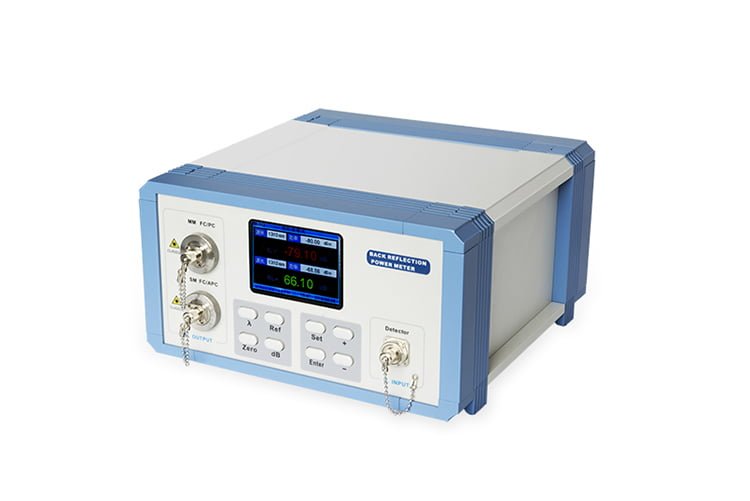RETURN LOSS & INSERTION LOSS Meters Testing Machines
RETURN LOSS & INSERTION LOSS Meters Testing Machine patch cord and pigtail manufacture line
Mefiberoptic offers a range of return loss and insertion loss test equipment in single channel, multichannel and bi-directional configurations To Check the finished patch cable insertion loss and Return Loss in patch cord and pigtail production line .Insertion Loss (IL) and Return Loss (RL) Meters build on the well proven capabilities of the fastest RL meters in the industry
The condition and characteristics of fiber optic connectors greatly affects the performance of an installed fiber optic link. High connector loss (e.g., insertion loss), low return loss, or high reflectance will impair an application (i.e. 10GBASE-LRM) from running on a network. A high return loss is a good thing and usually results in low insertion loss. Let’s examine the differences between these three terms because they can be confusing.
Optical loss (for connectors), sometimes called attenuation, is simply the reduction of optical power induced by transmission through a medium such as a pair of fiber optic connectors. Return loss is the amount of light reflected from a single discontinuity in an optical fiber link such as a connector pair. Return loss is also called reflectance. For perfect transmission, optical loss and reflected power should be zero.
The equations for optical loss, return loss and reflectance are as follows:
Optical Loss = 10*log(input power/output power) in +dB
Return Loss = 10*log(incident power/reflected power) in +dB
Reflectance = 10*log(reflected power/incident power) in -dB
Return loss and reflectance are both used to describe back reflection at a connector pair. However, one has a negative dB sign and one has a positive dB sign. Perhaps reflectance has its origins in the electrical world where return loss having a negative sign is more properly called the reflection coefficient.
What Is Insertion Loss?
In telecommunications, insertion loss refers to the loss of signal power, calculated as a ratio in dB (decibel), resulting from inserting a device in a transmission line or optical fiber. It can also be referred to as attenuation, which indicates how much the signal loss is by comparing the input power to the output power. A lower insertion loss value indicates a better insertion loss performance. For example, an insertion loss of 0.3dB is better than 0.5dB.
What Is Return Loss?
When a signal is transmitted through a transmission line, some signal power is always reflected or returned to the source due to discontinuities in the transmission line. The discontinuity can be a mismatch with the terminating load or with a device inserted in the line. Return loss refers to the loss of reflected signal power. Therefore, the higher the return loss is, the lower the amount of reflection will be. That is to say, the fiber connector will have better performance with a higher value of RL.
What Causes Poor Insertion Loss and Return Loss?
Ideally speaking, if the fiber patch cable has no connections, then the minimum loss will be realized—a continuous, straight-through glass fiber from Point A to Point B with no interruptions. However, the fiber optic networks are requiring connectors for modularity. The desired low IL and high RL performance are reduced consequently on account of the following three factors:
End-face Quality and Cleanliness

End-face Cleanliness
Evidently, fiber end-face defects like scratches, pits, cracks, and particle contamination will have a direct impact on the performance, contributing to poor insertion/return loss. Any irregularity that impedes light transmission from one fiber to the other will negatively affect IL and RL.
Misalignment Between the Two Cores
The main task of the connector is to hold the fibers precisely, ensuring the core of one fiber will align neatly and accurately with the core of the other fiber, so as to make every connector to mate with another connector with precise core alignment and core-to-core contact. Normally speaking, the smaller the ferrule hole diameter, the more precisely the fiber will be centered in the ferrule. If the ferrule hole is not perfectly centered, the fiber it holds will obviously never be perfectly centered. Therefore, the misalignment between two cores often happens when the fibers with the light-carrying cores are not aligned perfectly with each other, resulting in poor IL/RL.

Two Cases of Misalignment Situations
Poor Core-to-core Contact
In order to achieve the desired low IL and high RL, optimized core-to-core contact must be achieved and maintained. Different polishing styles of fiber connectors have varied core-to-core contact performance regarding the connector’s insertion loss and return loss. Usually, the insertion loss of PC, UPC, and APC connectors is less than 0.3dB. However, UPC connectors have the lowest IL due to the smallest air gap while APC connectors have the highest RL due to the beveled fiber end-face. PC vs UPC vs APC Connector will help you to select the proper fiber connect type.

Core-to-core Contact of PC vs UPC vs APC


